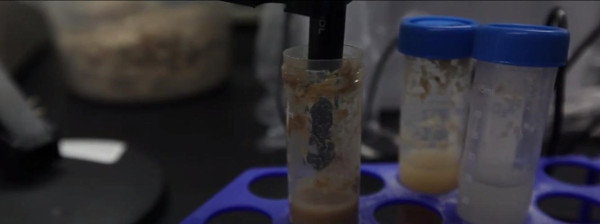Biofuels: Producing Ethanol from Cellulosic Material
Overview
Source: Laboratories of Margaret Workman and Kimberly Frye - Depaul University
In this experiment, cellulosic material (such as corn stalks, leaves, grasses, etc.) will be used as a feedstock for the production of ethanol. The cellulosic material is first pretreated (ground and heated), digested with enzymes, and then fermented with yeast. Ethanol production is monitored using an ethanol probe. The experiment can be extended to optimize ethanol production by varying the feedstock used, pretreatment conditions, enzyme variation, yeast variation, etc. An alternative method of monitoring the reaction is to measure the carbon dioxide produced (using a gas sensor) instead of the ethanol. As a low-tech alternative, glucose meters (found in any drug store) can be used to monitor the glucose during the process, if an ethanol probe or carbon dioxide gas sensor is not available.
With an increased emphasis on ‘inquiry-based learning”, scientific probes are becoming more popular. Handheld devices like the Vernier Lab Quest used in conjunction with a variety of probes (such as those for conductivity, dissolved oxygen, voltage, and more) allow for less focus on collecting data and/or making graphs and more on analyzing the data and making predictions. Another advantage is that these are small and lightweight and can be taken into the field for measurements.
Procedure
1. Sample Preparation
- Select cellulosic material to be used as feedstock. This can be corn stalks, grasses, leaves, pet bedding, or paper.
- Using a ball mill grinder (or coffee grinder if ball mill grinder is not available), grind feedstock into a fine powder with no large pieces remaining.
- Measure 1.0 g of feedstock and place in a 50-mL centrifuge tube. Label the tube with the feedstock chosen.
- Label a second 50 mL centrifuge tube as “Control”. Do
Results
The % ethanol in the solution will be displayed on the handheld tablet screen using the software related to the brand of the ethanol sensor used (Figure 2).
Representative results of the percent ethanol produced by various feedstocks can be seen in Table 1.
| Feedstock | Ethanol produced |
| Sawdust | 0.7Application and SummaryThe Energy Independence and Security Act of 2007 set into law a renewable fuel standard. It created a phase-in for renewable fuel volumes starting at 9 billion gallons in 2008 and ending at 36 billion gallons in 2022. Of that 36 billion, it was expected that 16 billion of that would come from cellulosic materials. For 2014, the original proposal was for 18.15 billion gallons of renewable fuel, 1.75 billion of that coming from cellulosic material. Unfortunately, based on the volume of cellulosic ethano References
TagsSkip to... Videos from this collection:  Now Playing Biofuels: Producing Ethanol from Cellulosic MaterialEnvironmental Science 53.5K Views  Tree Identification: How To Use a Dichotomous KeyEnvironmental Science 81.4K Views  Tree Survey: Point-Centered Quarter Sampling MethodEnvironmental Science 49.5K Views  Using GIS to Investigate Urban ForestryEnvironmental Science 12.7K Views  Proton Exchange Membrane Fuel CellsEnvironmental Science 22.2K Views  Testing For Genetically Modified FoodsEnvironmental Science 90.1K Views  Turbidity and Total Solids in Surface WaterEnvironmental Science 35.9K Views  Dissolved Oxygen in Surface WaterEnvironmental Science 56.0K Views  Nutrients in Aquatic EcosystemsEnvironmental Science 39.0K Views  Measuring Tropospheric OzoneEnvironmental Science 26.5K Views  Determination Of NOx in Automobile Exhaust Using UV-VIS SpectroscopyEnvironmental Science 30.3K Views  Lead Analysis of Soil Using Atomic Absorption SpectroscopyEnvironmental Science 125.9K Views  Carbon and Nitrogen Analysis of Environmental SamplesEnvironmental Science 29.6K Views  Soil Nutrient Analysis: Nitrogen, Phosphorus, and PotassiumEnvironmental Science 216.2K Views  Analysis of Earthworm Populations in SoilEnvironmental Science 16.6K Views Copyright © 2025 MyJoVE Corporation. All rights reserved |

